久米島DIVE ESTIVANTさんでのBlack Water Dive®を今年は計4回開催します。
まずは7-8月の開催告知です。
第1弾 7月28日(木)~31日(日)
第2弾 8月4日(木)~7日(日)
(この期間中であれば1日から参加可能です。)
7-8月は昨年大フィーバーした久米島の北側のポイントでの開催が可能なシーズンです。今年は週末を挟んだ2週間に渡って開催いたします。
この北側でのBlack Water Dive®では、おそらくまだフィールドでの生態を見た人は地球上に数人しかいない外洋性の複数種のイカたちや稚魚たちが現れます。しかも、それぞれが圧倒的な数量を誇りますので、今までに開催してきたBlack Water Dive®開催地の中でもその量も意外性も随一のエリアです。
現地ではダイブ エスティバンの川本剛志さんをはじめ、ベテランスタッフ陣が皆さんのガイドとしてサポートしてくれます。
また、今回もAOI JAPAN様から、RGBlueシリーズを複数台ご協力いただきます。
(昨年の様子)
http://www.blackwaterdive.net/2015_09_21_archive.html
DIVE ESTIVANTでのBlack Water Dive®詳細なご案内は pdf をご用意してます。
お申し込みはDIVE ESTIVANTさんに直接お申し込みください。
ダイブ エスティバン
住所 : 〒901-3108 沖縄県島尻郡久米島比嘉160-69
TEL : 098-985-7150
お申し込み&お問い合わせ先
HP : http://www7b.biglobe.ne.jp/~dive-estivant/
E-Mail : estivant@mrh.biglobe.ne.jp
人気の開催場所となりますので、大勢の方のお申し込みが予想されますが、
参加人数を限定して開催しております為、お申し込み頂きました方から、
先着順に締め切らせていただきます。
久米島での2016年の開催の第3弾と第4弾は、引き続き10-11月に予定しております。
久米島開催 第3弾と第4弾の日程は久米島マラソン2016開催により、
下記の日程に変更になりました。(2015/5/20現在)
第3弾 10月27日(木)~30日(日)
第4弾 11月03日(木)~05日(土)
This is official site of Black Water Dive® produced by photographer Ryo Minemizu. Black Water Dive® is a kind of night diving. We are setting up underwater lights of high-color rendering on the sea bottom of night that while considering tides, times, places. The creature which appears is mainly juveniles and larvae. All is fascinating, and it's not to be seen at daytime or regular night diving. It will be your first experience. This site will introduce the state of the event and the creatures seen and also future of BWD schedules. *"BWD"stands for Black Water Dive®.*Black Water Dive® is a registered trademark of Ryo Minemizu.
2016年5月13日金曜日
2016年4月19日火曜日
Report of DayDream RYOMA-1 Midnight Dive & Black Water Dive® Collaboration Cruise
パラオの稚魚たち
4/9-17の日程で行っておりましたパラオ。DayDream RYOMA-1 Midnight Dive & Black Water Dive® Collaboration Cruiseの結果報告です。
 |
| 今回のRGBlueには、マンフロットの新型ミニ三脚 PIXI-EVOを中心に取り付けています。安定性抜群。 |
リーフ棲の魚類を中心にご紹介いたします。
ウナギ目のレプトセファルス期は今回も数多く表れ、複数種が見られました。
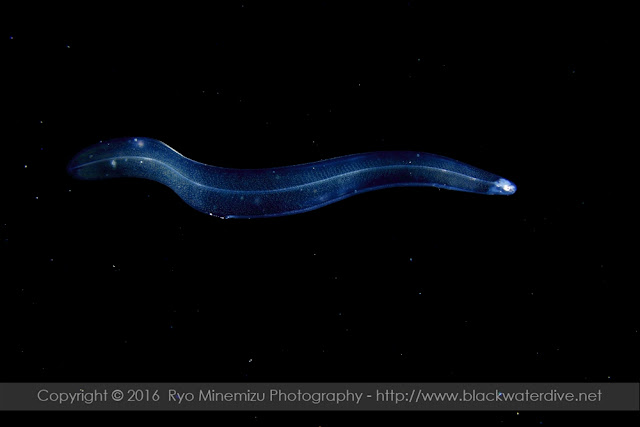 |
| ウナギ目のレプトセファルス期 TL:90mm |
カクレウオ類のベクシリファー期・テニュイス期ともに、こちらも数多く出現しました。
 |
| カクレウオのベクシリファー期 TL:40mm |
胸鰭をヒラヒラと羽ばたきながら泳ぐハダカハオコゼの稚魚。リーフの上にいるときはじっとしているのに、遊泳期は比較的泳ぎが達者です。
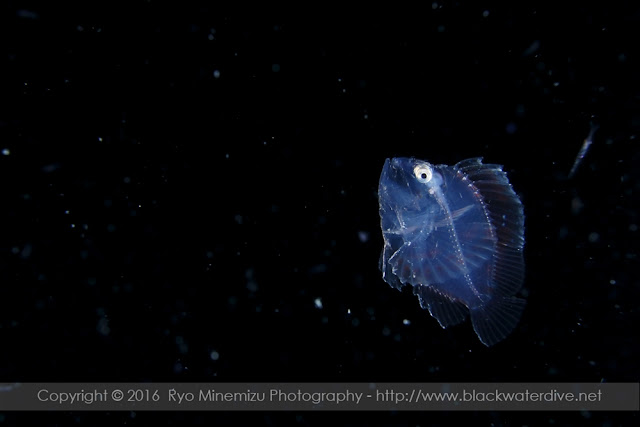 |
| ハダカハオコゼの稚魚 TL:50mm |
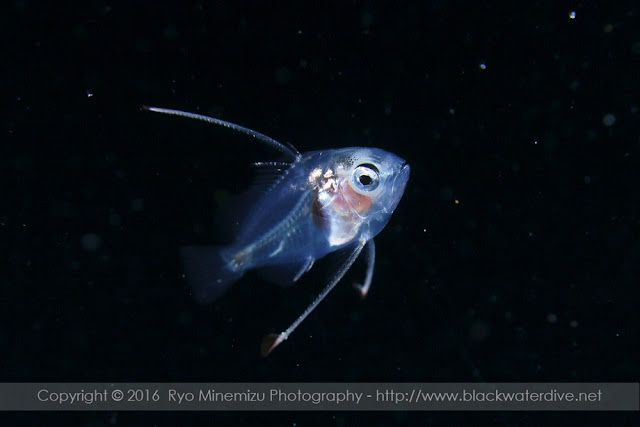 |
| ハタ亜科稚魚 TL:20mm |
 |
| セミホウボウのケファラカンサス期稚魚 TL:45mm |
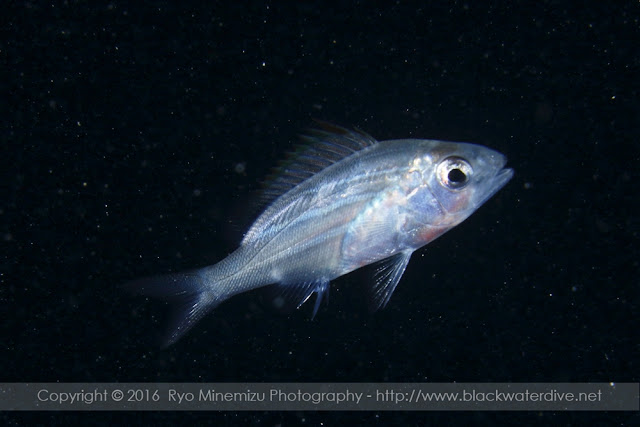 |
| ヨスジフエダイ稚魚 TL:25mm |
 |
| コチ科の稚魚 TL::23mm |
 |
| ハナダイ亜科の稚魚 TL:25mm |
赤い斑点が均等に配置されるのが特徴。着底するとかなり地味に
 |
| フサカサゴ科の稚魚 TL:25mm |
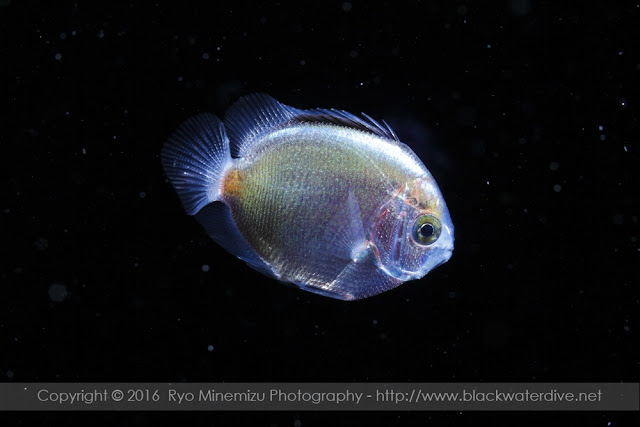 |
| キンチャクダイ科の稚魚 TL:30mm |
 |
| ヤリカタギ稚魚 TL:17mm |
 |
| フグ科稚魚 TL:10mm |
 |
| コンゴウフグ属稚魚 TL10mm |
 |
| キヘリモンガラ稚魚 TL:32mm |
 |
| アカマツカサ属のリンキクチス期 TL:20mm |
出現種はまだまだいるのですが、続きは折を見てご紹介することにします。また、今回、坂上治郎さんの研究対象でもある深海性魚類も出現しましたが、ここでの掲載は差し控えておこうと思います(またの機会にでも)
パラオの頭足類たち
パラオの夜の海では様々な頭足類(Cephalopoda)も数多くみられます。ホタルイカモドキ科では、フィリピンホタルイカ Abralia (Abralia) spaercki Grimpe, 1931の他、オビスジホタルイカ Abralia (Abralia) steindachneri Weindl, 1912なども上げられます。オビスジホタルイカの既知の分布域(東シナ海からインドネシア,インド洋,紅海からオーストラリア西岸の熱帯域)にパラオは含まれていませんが、おそらく、これよりもさらに広範囲に分布しているものと思われます。
 |
| フィリピンホタルイカ Abralia (Abralia) spaercki Grimpe, 1931 ML:40mm |
アカイカ科では、トビイカ Sthenoteuthis oualaniensis (Lesson, 1830)の他、Sthenoteuthisの隠ぺい種が1-2種ほど、ヤセトビイカ Ornithoteuthis volatilis (Sasaki, 1915)などが代表的です。
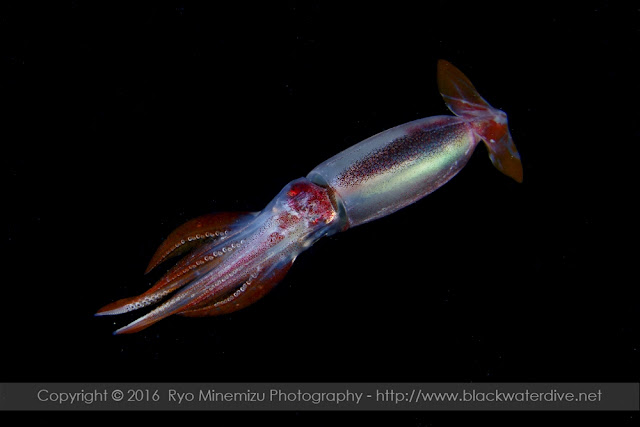 |
| トビイカ Sthenoteuthis oualaniensis (Lesson, 1830) ML:25cm |
 |
| ヤセトビイカ Ornithoteuthis volatilis (Sasaki, 1915) ML:15cm |
 |
| Sthenoteuthis sp.1 Sthenoteuthis属の隠ぺい種 ML:18cm |
 |
| マダコ科 幼生 不明種 |
 |
| ムラサキダコ Tremoctopus gracilis (Eydoux & Souleyet, 1852) ,male, ML:15mm |
 |
| 腕の吸盤上にカツオノエボシのものと思われる触手を付着させている |
REFERENCES
沖山 宗雄 (編集)(2014). 日本産稚魚図鑑
奥谷 喬司, (2015). 新編 世界イカ類図鑑
P. Jereb & C.F.E. Roper, (2010). Cephalopods of the world. An annotated and illustrated catalogue of cephalopod species known to date. Volume 2. Myopsid and Oegopsid Squids. FAO Species Catalogue for Fishery Purposes. No. 4, Vol. 2. Rome, FAO. 605p
Norman MD, Paul D, Finn J & Tregenza T (2002). First encounter with a live male blanket octopus: the world's most sexually size-dimorphic large animals. New Zealand Journal of Marine and Freshwater Research, Vol 36.
Tremoctopus - Tree of Life Web Project
場所:
パラオ
2016年4月8日金曜日
Palau Day Dream RYOMA-1 Midnight Dive & Black Water Dive® collaboration cruise
Soon departure
Palau DayDream RYOMA-1 Midnight Dive & Black Water Dive® collaboration cruise.
9th to 17th, Apr 2016.
2016年4月5日火曜日
Larva of Pleuronectes yokohamae Günther, 1877 from Toyama Bay
Japanese common name: Mako-garei
Latin name: Pleuronectes yokohamae Günther, 1877
"Mako-garei" have a wide distribution to Japanese-sea. Image was taken in mid-March.
In the larva that seen in this season was the top dominant species.
REFERENCES
Okiyama M. ed (2014) An Atlas of Early Stage Fishes in Japan Second Edition Tokai University Press, Japan. :217–268. (in Japanese).
Kojima J (2014) ウッカリカサゴのブログ-仔稚魚スケッチ-カレイ科
Latin name: Pleuronectes yokohamae Günther, 1877
"Mako-garei" have a wide distribution to Japanese-sea. Image was taken in mid-March.
In the larva that seen in this season was the top dominant species.
 |
| Juvenile of Pleuronectes yokohamae Günther, 1877 (size: about 12mm) |
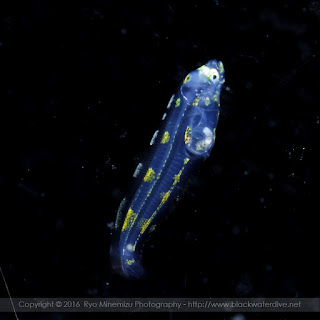 |
| more younger size: 10mm |
REFERENCES
Okiyama M. ed (2014) An Atlas of Early Stage Fishes in Japan Second Edition Tokai University Press, Japan. :217–268. (in Japanese).
Kojima J (2014) ウッカリカサゴのブログ-仔稚魚スケッチ-カレイ科
2016年4月1日金曜日
The Firefly squid of Toyama Bay
English name: Firefly squid
Latin name: Watasenia scintillans (Berry, 1911)
Toyama Bay is famous for Firefly squid production. That mainly season is between March to May. This season is for Spawning. Distribution of Firefly squid is around Japan of Okhotsk Sea from coast of South Japan. Among them, the largest Firefly squid live in Toyama Bay, common size is ML70mm. It's much larger than those of other regions.
REFERENCES
Watasenia scintillans - Tree of Life Web Project
Latin name: Watasenia scintillans (Berry, 1911)
Toyama Bay is famous for Firefly squid production. That mainly season is between March to May. This season is for Spawning. Distribution of Firefly squid is around Japan of Okhotsk Sea from coast of South Japan. Among them, the largest Firefly squid live in Toyama Bay, common size is ML70mm. It's much larger than those of other regions.
 |
| Firefly squid, Watasenia scintillans (Berry, 1911) |
 |
| eggs drifting in underwater |
 |
| Two to four large organs covered by black chromatophores on tips of arms IV. |
REFERENCES
Watasenia scintillans - Tree of Life Web Project
Some jellies in early spring of Toyama bay.
In early spring of Toyama Bay, we were able to find meny number of jellies. Among them, the comb jellyfish was seen many. Sea temperature is 10 or 11 degrees celsius.
This Cydippida sp. of size is about 20mm. it's had mature eggs.
This Hormiphora has a secondary tentacles of yellowish. Size is 45mm.
Aglantha digitale is one of Trachymedusae. In early summer from spring, It can see the coast of Hokkaido from Northeast and Hokuriku Japan. Umbrella of muscular glow to rainbow colors depending on the angle of light.
Beroe mitrata looks like Beroe forskalii. but, the pharynx of Beroe mitrata is characteristic by dyed red.
This individual is still young, size is only about 30mm.
Cyclosalpa bakeri habittat around from 45 degrees north latitude to near 40 degrees south latitude of East Atlantic, Pacific Ocean and Indian Ocean.
Thetys vagina is biggest in solitary zooid of Salpida. This individual size is about 170mm.
REFERENCES
Ryo Minemizu et al ,2015 A Photographic Guide to the Jellyfishes of Japan. 360pp. Heibonsha, Tokyo Japan. (in Japanese)
This Cydippida sp. of size is about 20mm. it's had mature eggs.
 |
| Cydippida sp. |
This Hormiphora has a secondary tentacles of yellowish. Size is 45mm.
 |
| Hormiphora sp. |
Aglantha digitale is one of Trachymedusae. In early summer from spring, It can see the coast of Hokkaido from Northeast and Hokuriku Japan. Umbrella of muscular glow to rainbow colors depending on the angle of light.
 |
| Aglantha digitale (Müller, 1776) |
Beroe mitrata looks like Beroe forskalii. but, the pharynx of Beroe mitrata is characteristic by dyed red.
This individual is still young, size is only about 30mm.
 |
| Young of Beroe mitrata (Moser, 1908) |
Cyclosalpa bakeri habittat around from 45 degrees north latitude to near 40 degrees south latitude of East Atlantic, Pacific Ocean and Indian Ocean.
 |
| Aggregate zooid of Cyclosalpa bakeri Ritter, 1905 |
 |
| Aggregate zooid of Cyclosalpa bakeri Ritter, 1905 |
Thetys vagina is biggest in solitary zooid of Salpida. This individual size is about 170mm.
 |
| Solitary zooid of Thetys vagina Tilesius, 1802 |
REFERENCES
Ryo Minemizu et al ,2015 A Photographic Guide to the Jellyfishes of Japan. 360pp. Heibonsha, Tokyo Japan. (in Japanese)
Unidentified Clionidae species in Toyama Bay.
We did pre Black Water Dive® at Namerikawa of Toyama Bay from 18th Mar to 20th Mar. Sea temperature was 10 degree. Visibility is not very well at that time, the results are were few. Most that we have found, it's common in the drifting plankton and nekton. However, there was a new discovery.
This is a very small Clionidae species. Size only 2mm. Cilia ring is three-stage.
So far, C, limacina limacina has not a report from Toyama Bay.
This species has also been reported from water sampling facilities of deep sea water of Toyama so far, and it has been found to be a new species.
Oct/12/2017 Postscript
There seems to be some announcement today.
http://www.tokyo-np.co.jp/s/article/2017101201000867.html
http://www.sanyonews.jp/article/610835/1/
富山湾で発見されたクリオネの仲間ですが、蘭越町貝の館の山崎さんや富山大学らの共同研究により、新種記載されることになりました。
This is a very small Clionidae species. Size only 2mm. Cilia ring is three-stage.
So far, C, limacina limacina has not a report from Toyama Bay.
This species has also been reported from water sampling facilities of deep sea water of Toyama so far, and it has been found to be a new species.
 |
| Clionidae species |
There seems to be some announcement today.
http://www.tokyo-np.co.jp/s/article/2017101201000867.html
http://www.sanyonews.jp/article/610835/1/
富山湾で発見されたクリオネの仲間ですが、蘭越町貝の館の山崎さんや富山大学らの共同研究により、新種記載されることになりました。
ラベル:
Clionidae,
クリオネ,
滑川,
富山湾の新種ハダカカメガイ
場所:
日本, 富山県滑川市
登録:
投稿 (Atom)


